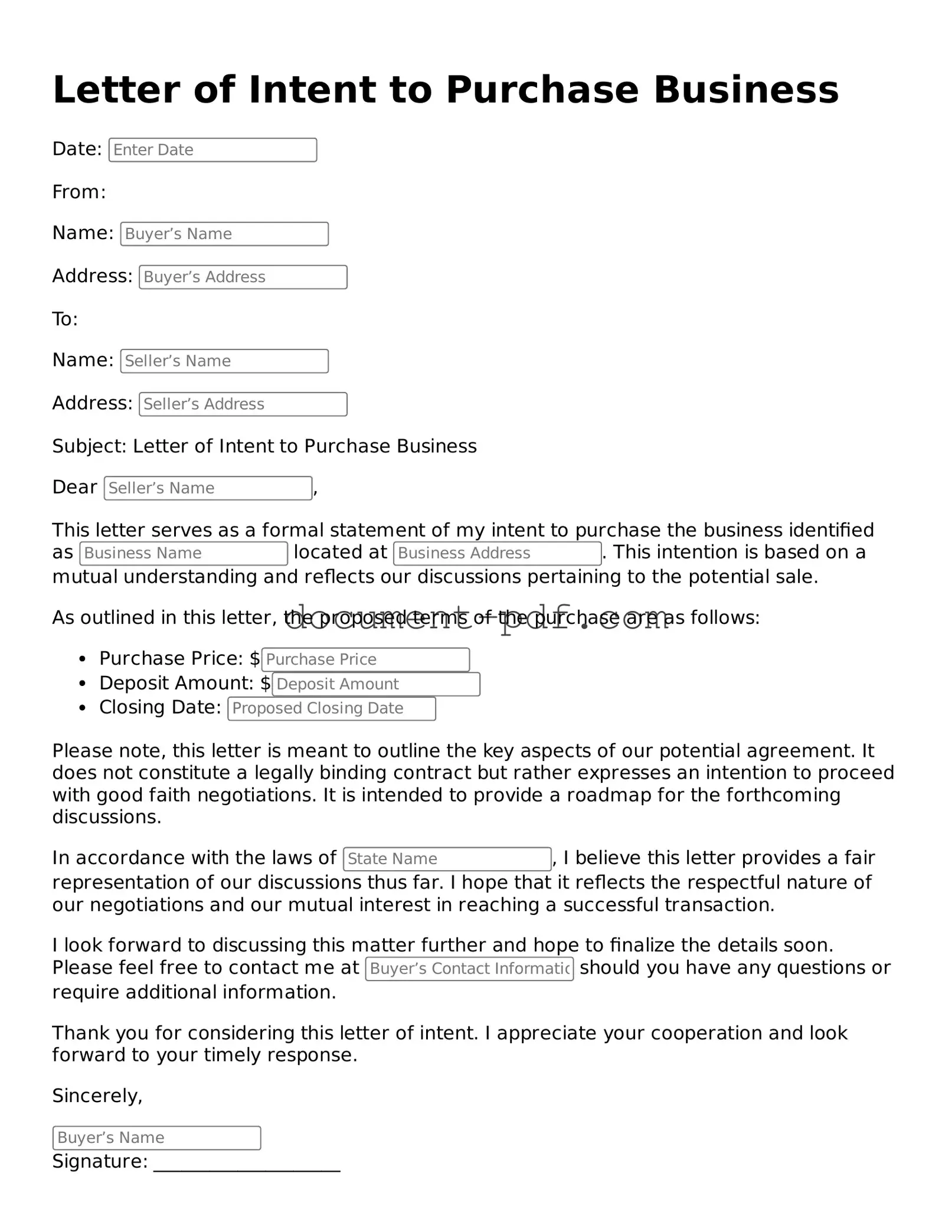The Letter of Intent (LOI) to Purchase Business form shares similarities with the Purchase Agreement. Both documents outline the terms of a business transaction, but the Purchase Agreement is more detailed and legally binding. While the LOI serves as a preliminary expression of interest, the Purchase Agreement finalizes the sale terms, including price, payment structure, and closing conditions. This transition from intent to a formal agreement marks a crucial step in the business acquisition process.
In the landscape of business transactions, understanding the nuances of various documents is essential to navigate the complexities of negotiations effectively. An Investment Letter of Intent serves as a crucial preliminary document that indicates a party’s commitment to investing, akin to the more commonly used Letter of Intent (LOI) in business acquisitions. Through this process, entities often rely on resources like UsaLawDocs.com to obtain the necessary templates and guidance needed for drafting such critical documents.
An Asset Purchase Agreement is another document that resembles the LOI. Like the LOI, it outlines the terms of a transaction, but it specifically focuses on the acquisition of a company's assets rather than its stock or ownership. Both documents serve as a framework for negotiations, allowing parties to agree on key elements before drafting a more comprehensive contract. The Asset Purchase Agreement provides clarity on which assets are included in the sale, while the LOI sets the stage for discussions.
The Confidentiality Agreement, also known as a Non-Disclosure Agreement (NDA), is similar in that it protects sensitive information shared during negotiations. Both the LOI and the NDA establish a level of trust between the parties. While the LOI indicates a serious interest in pursuing a deal, the NDA ensures that proprietary information remains confidential throughout the negotiation process. This mutual understanding is essential for both parties to feel secure in sharing pertinent details.
A Term Sheet is another document that parallels the LOI. It provides a summary of the key terms and conditions of a proposed agreement, similar to how the LOI outlines the intentions of the buyer and seller. While the LOI is often less formal, the Term Sheet can serve as a more structured overview of the deal, highlighting critical aspects such as valuation, financing, and timelines. Both documents facilitate discussions and help streamline the negotiation process.
The Memorandum of Understanding (MOU) is akin to the LOI, as both documents express a mutual agreement between parties. The MOU often covers broader terms and may include additional details about the relationship and responsibilities of each party. While the LOI focuses specifically on the intent to purchase, the MOU can encompass various aspects of a partnership or collaboration, creating a foundation for future agreements.
An Offer to Purchase is another document that shares characteristics with the LOI. This document is a formal proposal made by a buyer to purchase a business or its assets, outlining the price and terms. Like the LOI, the Offer to Purchase indicates serious intent but typically includes more specific details about the offer itself. Both documents serve as starting points for negotiations, paving the way for more detailed agreements.
The Buy-Sell Agreement is similar in that it outlines the terms under which business owners can buy or sell their interests in a business. While the LOI focuses on a specific transaction, the Buy-Sell Agreement provides a framework for future transactions between owners. Both documents aim to clarify the terms of ownership transfer, ensuring that all parties understand their rights and obligations.
A Letter of Intent to Lease is comparable to the LOI for purchasing a business. This document expresses a potential tenant's interest in leasing a property, outlining key terms such as rental rate and duration. Both letters serve as preliminary agreements that indicate serious intent and establish the groundwork for a formal lease agreement. They help facilitate discussions and negotiations between landlords and prospective tenants.
The Engagement Letter is another document that resembles the LOI in its purpose of establishing a working relationship. Often used in professional services, this letter outlines the scope of work, fees, and expectations between a client and service provider. While the LOI indicates intent to purchase a business, the Engagement Letter signifies the beginning of a professional relationship, setting the stage for future collaboration.
Finally, the Intent to Negotiate document is similar to the LOI as it expresses a party's willingness to enter negotiations regarding a potential agreement. Both documents highlight the seriousness of the parties involved and establish a framework for discussions. While the Intent to Negotiate may not specify the details of a transaction, it signals a commitment to explore possibilities, much like the LOI does in the context of a business purchase.
